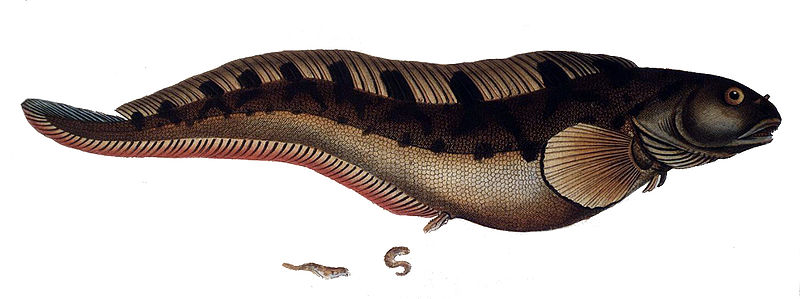 Hello, Frank Indiviglio here. Aquarists have long known that Discus Fish (Symphysodon spp.) produce mucus with which to feed their young. However, recent studies revealed unexpected new parenting behaviors, leading some ichthyologists to compare them to mammals. Just as surprising is the discovery that the European Eelpout (Zoarces viviparus), a commercially valuable marine fish, actually suckles it young with a milk-like secretion!
Hello, Frank Indiviglio here. Aquarists have long known that Discus Fish (Symphysodon spp.) produce mucus with which to feed their young. However, recent studies revealed unexpected new parenting behaviors, leading some ichthyologists to compare them to mammals. Just as surprising is the discovery that the European Eelpout (Zoarces viviparus), a commercially valuable marine fish, actually suckles it young with a milk-like secretion!
Weaning Behavior
The surprising new information about Discus appeared in the October 29, 2010 issue of the Journal of Experimental Biology. While observing a breeding colony of the much-admired South American fishes, University of Plymouth (UK) biologists noticed that both parents avidly fed the young with mucus secretions for 2 weeks. The fry were allowed to feed from an adult’s body for approximately 10 minutes, after which the ravenous little fellows were “flicked” onto the mate for more food.
By the third week after birth, however, both parents began swimming away from the fry for short periods…causing the hungry youngsters to sample foods in their environment. Much like a mammalian mother weaning her young, the Discus parents gradually left their fry for increasingly long periods; by week 4 the young Discus were largely foraging on their own.
Mucus-Milk Comparison
Analysis of the mucus produced by breeding Discus showed that protein and antibiotic levels soared right around the time of egg-laying, much as they do in mammalian milk when the young are born. The mucus’ protein/antibiotic content dropped back to pre-spawning levels by week 3, when the young began feeding on their own.
Just as is the case for mammals and birds, the changes in the Discus parents’ behavior and food production seem designed to force the young to survive unassisted, so that the adults can put their resources into another brood.
An Amazing Adaptation
 Female European Eelpouts have evolved an even more “mammalian” form of parental care – nursing! Eelpouts give birth to live young; in all other live-bearing fishes studied, the developing fry feed from yolk sacs while within the mother’s body. Eelpouts remain pregnant for 6 months, however, and give birth to large, well-formed young. The time involved and size of the offspring rules out egg yolk as food source.
Female European Eelpouts have evolved an even more “mammalian” form of parental care – nursing! Eelpouts give birth to live young; in all other live-bearing fishes studied, the developing fry feed from yolk sacs while within the mother’s body. Eelpouts remain pregnant for 6 months, however, and give birth to large, well-formed young. The time involved and size of the offspring rules out egg yolk as food source.
Female Eelpouts solve this dilemma in a manner unique among fishes – they produce a highly nutritious mixture of proteins, fatty acids and glucose for their young to feed upon. Amazingly, their “milk” is secreted from the ovarian follicles, which function much as do nipples in mammals! A single fry attaches to each ovarian follicle, assuring that all receive adequate nutrition.
In contrast to most Northern European fishes, Eelpouts give birth when the ocean water is very cold – perhaps their extreme form of maternal care is necessary to ensure that the young are robust enough to survive their icy introduction to life.
Discus are popular aquarium fishes, and Eelpouts have been harvested for centuries, yet both are still yielding surprises…the same can be said for nearly any fish. Please write in with your thoughts and observations – one never knows where the next discovery is hidden! Thanks, until next time, Frank Indiviglio.
Further Reading
For more detailed information, please see the original journal article Parental Care in Discus Fishes.
Video of Discus in the wild.
 That Fish Blog – Aquarium Advice and Information
That Fish Blog – Aquarium Advice and Information


One comment
Pingback: New Insights into the Mammal-Like Parenting of Discus Fishes and Eelpouts | Fish Mart